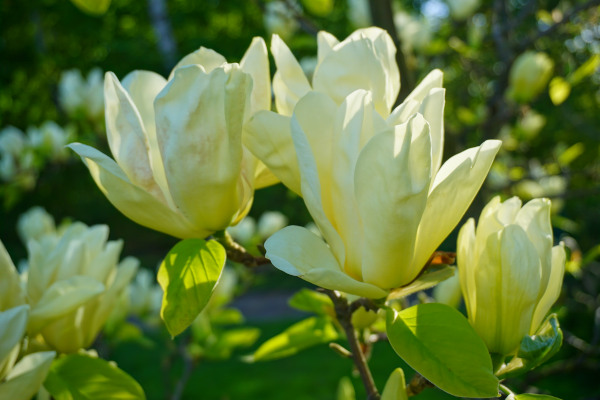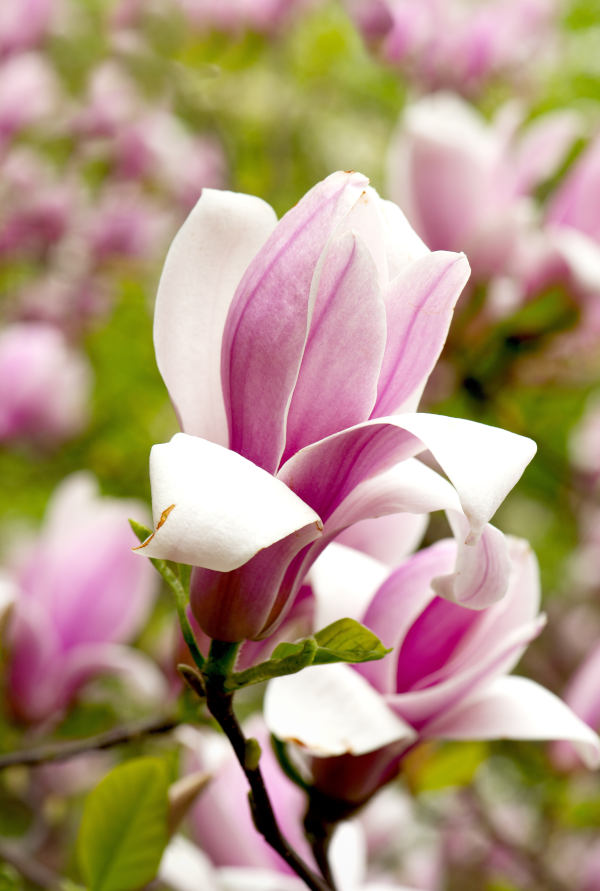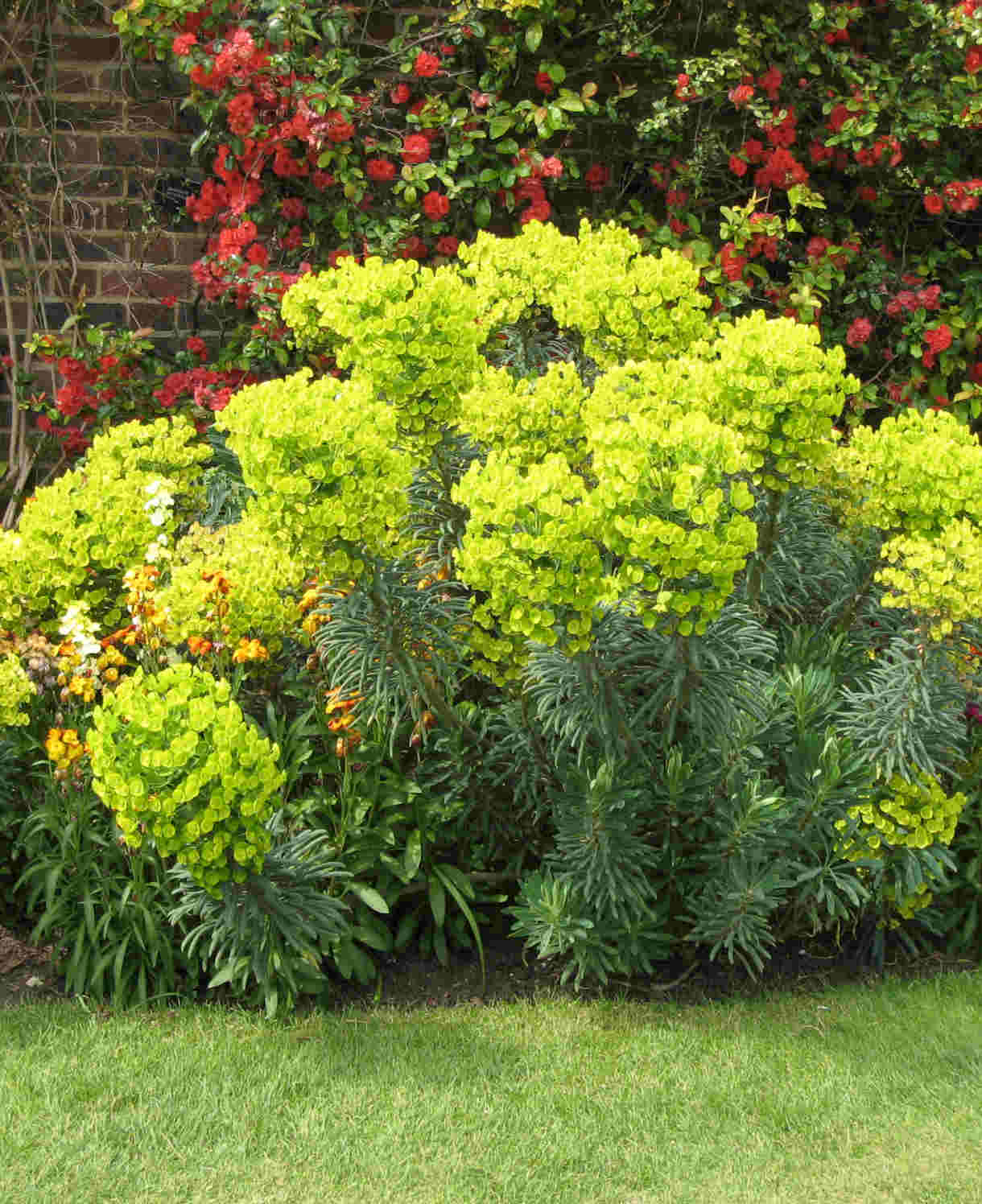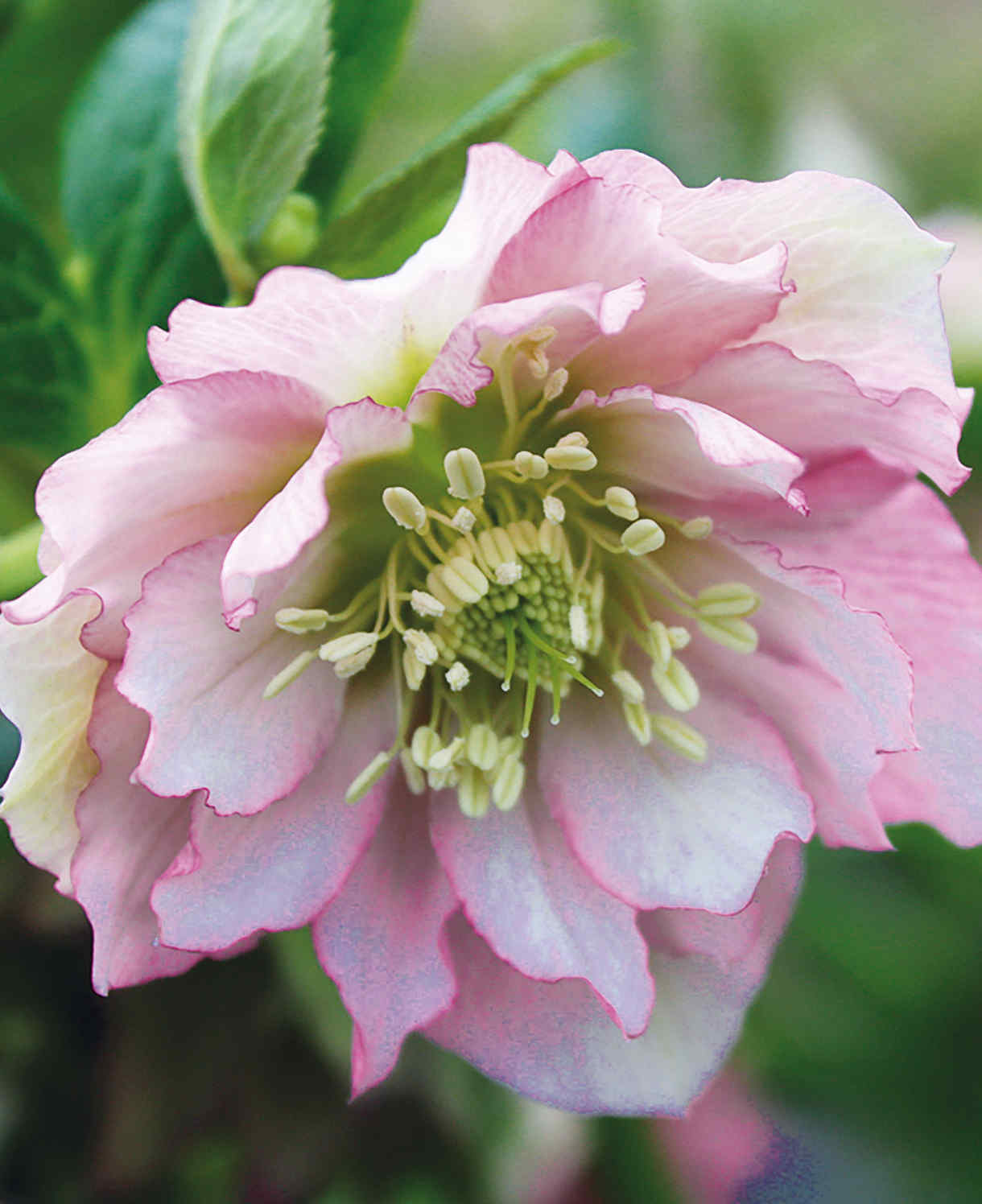How to grow Magnolia
Dating back over 100 million years, magnolias are among the most ancient flowering plants in existence. There are around 120 species – some classed as shrubs, others trees, and a few falling in between. They can be evergreen or deciduous and vary in size dramatically, meaning there can be an option found to suit almost any garden. They are cultivated for their sumptuous, often breathtaking display of large, showy flowers.
Magnolias can be split into two groups. Asian species tend to flower before the emergence of the leaves (apart from the evergreen species), often in hues of pink and purple. American species usually flower after the leaves have appeared, and can be expected to produce white, yellow, or cream blooms.
It is important when choosing a magnolia to be mindful of your climatic and growing conditions. Magnolia flowers can be damaged by temperatures dipping below around -3°C, so choosing a variety that blooms after the last risk of frost in your area is vital to avoid disappointment. Magnolias can also differ quite significantly in their soil preferences and only flower well when happy. As it may be several years before they flower and up to two decades before they reach full size, it is worth spending a little time initially to find the right species.

Zantedeschia is a genus of flowering plants from the family Araceae and is native to southern Africa. With a rich history dating back to the Ancient Romans, these deciduous or semi-evergreen perennials have been used as a symbol of celebration. Zantedeschia was Named after Professor Giovanni Zantedeschia, an Italian botanist.
There are two main forms of Zantedeschia: hardy and tender. Hardy forms of the plant can be grown outdoors, enjoy moist soil and full sun or partially shaded conditions - these are known as Arum lilies. Tender forms of Zantedeschia prefer being grown in containers or pots and should be brought inside over the winter - these are known as Calla lilies.
With tuberous flora in all colours from whites, yellows and oranges to deep reds and purples, Zantedeschias are not to be overlooked in any garden, as long as they have sufficient sunlight to grow in.
Ready to learn more about growing Zantedeschia? Read on for all there is to know...

Key Information
Soil pH
Position
Hardiness

Horticultural Divisions-
Species | Type | Hardiness | Tree or shrub | Height | Soil | Esp. well suited to partial shade? | Foliage | Flowering period | |||
Neutral to acidic | Alkaline | Moist yet well-draining | Dry | ||||||||
Magnolia acuminata | American | H6 (-15°C to -20°C) | Tree | 30m | ü |
| ü |
|
| Deciduous | Apr - May |
Magnolia stellata | Asian | H6 (-15°C to -20°C) | Shrub | 3-4m | ü | ü | ü |
|
| Deciduous | Mar – Apr |
Magnolia kobus | Asian | H6 (-15°C to -20°C) | Tree | 10m | ü | ü | ü |
|
| Deciduous | Mar – Apr |
Magnolia laevifolia | Asian | H5 (-10°C to -15°C) | Large shrub or small tree | 4m (dwarf cultivars available) | ü |
| ü |
|
| Evergreen | Mar – Apr |
Magnolia x loebneri | Asian | H6 (-15°C to -20°C) | Large shrub or small tree | 8m | ü | ü | ü |
|
| Deciduous | Mar – Apr |
Magnolia x soulangeana | Asian | H6 (-15°C to -20°C) | Large shrub or small tree | 6m | ü |
| ü |
| ü | Deciduous | Apr - May |
Magnolia x brooklynensis | Hybrid | H5 (-10°C to -15°C) | Tree | 10m | ü |
| ü |
| ü | Deciduous | Apr - May |
Magnolia Fairy Series | Hybrid | H5 (-10°C to -15°C) | Shrub | 3m | ü |
| ü | ü | ü | Semi-evergreen | Apr - May |
Magnolia grandiflora | American | H5 (-10°C to -15°C) | Tree | 12m | ü | ü | ü | ü |
| Evergreen | Jul - Sep |
Magnolia delavayi | Asian | H4 (-5°C to -10°C) | Shrub or tree | 10m | ü | ü | ü | ü |
| Evergreen | Jun - Nov |
Magnolia sieboldii | Asian | H6 (-15°C to -20°C) | Shrub | 4m | ü | ü | ü |
| ü | Deciduous | May - Aug |
Magnolia wilsonii | Asian | H6 (-15°C to -20°C) | Shrub | 6m | ü | ü | ü |
| ü | Deciduous | Apr – May |

Where & when to plant Magnolia
Position- Full sun preferred, though light, dappled shade is also tolerated.
Some species are particularly good at growing in partial shade (see table below).
Shelter from strong winds advisable.
Soil- Most prefer moist, fertile, well-draining soil with a neutral to slightly acidic pH.
Others grow well in alkaline and/ or dry soil. See table below for further information.
Flowering Period- Spring or summer depending on the species.
Hardiness- Varies according to species.
For best results, plant in autumn or spring. An autumn planting can be done by those gardening in mild conditions (and broadly speaking, this is the southern half of the UK). For those liable to cold winters, it is best to wait until spring (generally the northern half of the UK). Planting can also be carried out in summer, though be prepared to water regularly.
Whether used as a specimen plant or mixed with other trees and shrubs, all magnolias will thank you for a sunny spot out of strong winds. M. grandiflora is often grown as a wall shrub, as its lower tolerance to cold temperatures means it enjoys the warmth and protection of a stone or brickwork backdrop.
Magnolias can also make good container plants, particularly the more compact species or cultivars.
How to plant Magnolia
- For planting in the ground, dig the soil area removing any large stones and weeds and breaking up any lumps. Mix in some organic matter such as manure or garden compost. If your soil is heavy, now is also the time to add a generous helping of horticultural grit. Rake level and firm with your heels. Rake level again.
- Water plants well and allow to drain before planting.
- A good tip is to dig a hole twice the size of the root-ball. Fill with water and allow to drain before placing in the plant.
- Place the plant in the hole, ensuring the top of the root ball sits level with the surface of the soil. To high and the roots can dry out, too low and the stem can rot.
- Backfill with soil and firm in gently with your foot.
- Soak well with water.
- Mulch around the base with well-rotted organic matter.
- For planting in containers, first choose an appropriately sized pot. The best practice is to start just a few centimetres larger than the rootball and increase in size every year or two. Always ensure there are plenty of drainage holes in the bottom.
- If you are using a large or heavy pot, it can be a good idea to fill and plant it in situ to save yourself the trouble of moving once full.
- Use a good quality potting compost with plenty of horticultural grit mixed in, and, if not already present in the compost (check the description on the bag) some slow-release fertiliser granules.
- Start by partially filling the pot with compost; enough so that when placed on it the upper surface of the root ball is about 3cm lower than the top of the pot.
- Infill all the space surrounding the root ball with compost, firming down with your fingers then adding a little more so the plant is held tight. Again, take care not to bury the graft union (see above).
- Pick up the pot (if you can!) and lightly tap on the potting bench or ground a few times to help further settle the compost around the plant.
- Soak well with water.
- A mulch with horticultural grit will look attractive and help to prevent a ‘cap’ or crust forming on the top of the compost (something container plants can suffer due to the artificial nature of their watering).

What to plant with Magnolia
Take advantage of the spring light flooding through the bare branches of deciduous varieties, by underplanting with early flowering plants such as narcissus, snowdrops, and hellebores.
The underplanting of evergreen species, on the other hand, needs to be able to tolerate the shady and often dry conditions found beneath the dense, dark canopy. A few of our old, reliable favourites for these conditions are Euphorbia amygdaloides var. robbiae, liriope, dryopteris, Galium odoratum, and polystichum.



How to care for Magnolia
Pruning and Deadheading
Magnolias require little in the way of pruning and are best left to grow naturally, aside from a light tidy after flowering if necessary. This means removing any dead, diseased, damaged, or badly placed growth.
An mishappen or overgrown deciduous magnolia can be renovated over a three-year period. This means removing only a third of the branches at a time to avoid causing too much stress to the plant.
Watering
Magnolias should be regularly watered during their first few years in the ground, after which they should be largely self-sufficient other than in hot, dry conditions. It is important that magnolias are not allowed to dry out fully, so do remember to keep an eye on this. Magnolias grown in free-draining soil need more attention when it comes to watering, and will benefit from an extra mulch or two throughout the year to help lock in the moisture (see ‘Feeding’ section below). The same goes for magnolias grown against a wall, which can be sheltered from rain.
Container-grown magnolias have less access to moisture so need to be regularly watered throughout every growing season. Allowing the top couple of centimetres of compost to dry out between watering is a useful rule of thumb to help avoid overwatering. Use your finger inserted into the compost to check. From mid-autumn, the British climate tends to take over watering needs, though do remember to step in in the event of an unseasonably dry spell.
Feeding
To give them the best possible start, feed magnolias for their first few years in the ground with a general purpose granular feed applied to the surface of the soil and lightly worked in (known as a ‘top dress’). This is best done in late winter, along with a mulch of well-rotted organic matter (i.e., a layer of manure or garden compost applied to the soil around the plant). This has the added benefit of suppressing weeds and locking in moisture.
Once your magnolia is well established an annual mulch should provide sufficient nutrients, however apply a top dress as above if ever an extra boost is needed.
Container-grown plants rely even more on the gardener for nutrition. Get off to a flying start by making sure you use a good quality compost, then throughout the growing season (March to September) apply a liquid feed at regular intervals according to its instructions. An annual top dress is also advisable. Each spring, scrape off the top 5cm of compost and replace with fresh compost containing a little general purpose granular feed.
Cold Protection
If you live in a colder region, you may be best giving H4 and H5 rated species and cultivars a protected spot against a warm, sunny wall.
A late frost can damage magnolia flowers, so it is worth familiarising yourself with the average weather patterns in your area and choosing a species accordingly. For those further north, a later flowering variety is best. In milder areas, many of the earlier varieties are also an option.
Like all plants, those grown in containers can be more vulnerable to the cold. In the event of very low temperatures, it can be worth wrapping pots with hessian or fleece (this will protect the pot from cracking too).
Pests and Diseases
Magnolias are usually problem-free, though there are a couple of fungal diseases to be aware of.
Honey fungus tends only to be a problem where there is a heavily wooded area nearby, so is thankfully not a likely problem for most home gardeners. Phytopthora is a root rot which can occur on heavy, wet soils. Both will cause similar symptoms of dieback and sparse foliage, and unfortunately little can be done other than removing the affected specimen and replacing with a known resistant alternative. Quince (cydonia) and parrotia are rarely affected by either disease and make good magnolia substitutes.
How to propagate Magnolia
The easiest way to propagate magnolia is by layering (cuttings can be very tricky and seeds take a long time). Best done in spring or autumn, this simple and effective technique involves pegging a wounded stem to the ground to develop roots while still attached to the parent plant. It requires far less input than most other methods of propagation, as the plant is largely left to do the work.
- Choose a few flexible outer shoots that can easily be bent down to the surface of the soil.
- Make a 5cm long incision where the stem will touch the ground, ensuring you slice through a leaf bud.
- Insert a matchstick to wedge the incision open slightly.
- Dig a small, shallow trench where the shoot will touch the ground (adding a little grit if the soil is heavy).
- Peg the shoot into the trench using thick wire or a strong forked twig.
- Fill with soil, firm in, and water.
- Mark the spot with a cane. Roots can take 12 months to form, making it easy to forget what you have done and where...!
- When a good root system has formed, sever from the parent plant and either replant elsewhere or put in a pot for growing on.
* Many plants carry Plant Breeders Rights and cannot be propagated for commercial purposes.
Common Magnolia questions
What do magnolias need to grow?
The soil and temperature specifics vary depending on the variety, but a need for sunshine and shelter from the wind is universal.
How long does it take for a magnolia tree to grow to full size?
These are quite slow-growing plants that can take 10-20 years to reach their ultimate size.
Can you grow a magnolia from a cutting?
You can, although magnolia cuttings can be challenging to keep alive. Far quicker and easier is a technique known as ‘layering’, detailed above.
Do magnolia trees need a lot of watering?
Probably more that you’d think for the first few years, then after this usually only in hot, dry weather.
See our ‘Watering’ section above for more details.





